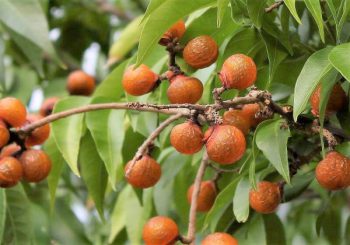Guest Writer for Wake Up World
Saponins are naturally occurring plant glycosides; which is to say they are phytochemicals – chemicals found in plants. They possess soap-like qualities and produce a lather when mixed with water.[1]
Over one hundred families of plants contain saponins and there are more than eleven classes of saponins including dammaranes, tirucallanes, lupanes, hopanes, oleananes, taraxasteranes, ursanes, cycloartanes, lanostanes, cucurbitanes, and steroids.[2] It’s believed many other varieties of saponins remain undiscovered.
[pro_ad_display_adzone id=”110028″]
The word saponin is derived from sapo, Latin for “soap.” True to its name, the root of the Saponaria, or soapwort plant, has been traditionally used as soap.[1]
Saponins offer tremendous health benefits. Studies have shown they may support the immune system, promote normal cholesterol levels, and support overall wellness.[3]
Why Are Saponins Beneficial?
Saponins have a unique chemical structure that produces foam when mixed with water, just like a detergent. And, also like detergent, saponins can bind with water as well as fats and oils. This means that, in the digestive tract, saponins produce an emulsification of fat-soluble molecules. Specifically, saponins bind to bile acids and help eliminate them from the body, preventing cholesterol from being reabsorbed. You might even say saponins “wash away” various toxins.
What Are the Health Benefits of Saponins?
The unique chemical structure of saponins allows them to offer a number of prospective health benefits. It’s believed saponins have a favorable effect on cholesterol, can help boost the immune system, have an antioxidant effect, and may even support bone strength.
Saponins and Cholesterol
Saponins seem to help promote normal cholesterol levels. The body uses cholesterol to produce the bile necessary for digestion. Saponins bind with bile and prevent cholesterol from being reabsorbed back into the bloodstream; rather, it’s simply excreted. Many cholesterol medications operate in the same way.
The cholesterol-lowering effect of saponins has been known for decades. A 1977 animal study found that saponins may reduce cholesterol absorption.[4] A separate study found that giving a certain saponin extract to rats with high cholesterol reduced “bad” (LDL) cholesterol without affecting “good” (HDL) cholesterol.[5]
Saponins Boost the Immune System
In nature, plants rely on saponins as a mechanism to fight parasites. Similarly, when consumed by humans, saponins provide a similar defense against harmful organisms. One study demonstrated this action against Candida cells, specifically.[6] In another study, a specific type of saponin was observed to have antimicrobial activity that favorably influenced oral health.[7] The ability of saponins to act as a broad, frontline shield reduces the burden on the immune system.
Saponins and Cancer
Saponins have several qualities that act against cancer cells. In particular, some saponins have an antioxidant effect[8] and may be directly toxic to cancer cells.[9]
Cancer cell membranes have cholesterol-type compounds. Like cholesterol, saponins are able to bind with these compounds and disrupt the proliferation of cancer cells. According to an article published in the Journal of Nutrition, saponins from soybeans may slow the growth of cancer cells.[10] Other studies have reported saponins have induced the death of cancer cells and slowed tumor growth.[11]
It’s important to realize that most of the research into the effects of saponins on cancer cells has been preliminary and involved specific enzymes, proteins, or other components of saponins extracted in specific ways and matched against specific cancer cells under specific situations. In other words, it’s not quite as simple as eating a handful of soapberries and thinking it will cure cancer.
Other Health Benefits of Saponins
Investigations into saponins have yielded a number of other, interesting revelations about their qualities. Preliminary research from a 2010 study concluded that saponins from Terminalia arjuna (arjun tree) may offer a therapeutic benefit for kidney or urinary stones.[12] In a 2015 issue of Natural Products Research, it was noted that, in the past ten years, several preclinical reports have suggested that saponins may offer hope as a natural solution for depression.[13]
Other positive qualities of saponins include supporting Kupffer cells in the liver and encouraging normal detoxification. Saponins found in oats and spinach support digestion by accelerating the body’s ability to absorb calcium and silicon. In animal studies, saponins have been found to promote balanced blood sugar and support normal bone density.[14, 15]
Where to Find Saponins
Saponins are a component in over a hundred different types of plants and foods including beans, chickpeas, peanuts, quinoa, and soy. Saponins exist in nightshade vegetables like tomatoes. Herbs like ginseng, Tribulus terrestris, jiaogulan, bupleurum root, osha, and collinsonia also contain saponins.
Saponins are common in food products, often added as an emulsifier. Some carbonated beverages like root beer rely on saponins extracted from yucca and quillaja to produce a foamy head.
The berry shell from the soapberry plant can be used as a natural laundry detergent. The hard shell, which resembles a nut, releases saponins when it absorbs water, acting as a detergent to release grime, dirt, and oil from clothing.
Sources and References:
- Cornell University. Department of Animal Science – Plants Poisonous to Livestock. Updated 09/10/2015 14:58:48.
- Man S, Gao W, Zhang Y, Huang L, Liu C. Chemical study and medical application of saponins as anti-cancer agents. Fitoterapia. 2010 Oct;81(7):703-14. doi: 10.1016/j.fitote.2010.06.004. Epub 2010 Jun.
- Shi J, Arunasalam K, Yeung D, Kakuda Y, Mittal G, Jiang Y. Saponins from edible legumes: chemistry, processing, and health benefits. J Med Food. 2004 Spring;7(1):67-78.
- Malinow MR, McLaughlin P, Papworth L, Stafford C, Kohler GO, Livingston AL, Cheeke PR. Effect of alfalfa saponins on intestinal cholesterol absorption in rats. Am J Clin Nutr. 1977 Dec;30(12):2061-7.
- Hiromichi Matsuura. Saponins in Garlic as Modifiers of the Risk of Cardiovascular Disease. The Journal of Nutrition. March 1, 2001.
- Jeffrey J. Coleman, Ikechukwu Okoli, George P. Tegos, Edward B. Holson, Florence F. Wagner, Michael R. Hamblin and Eleftherios Mylonakis. Characterization of Plant-Derived Saponin Natural Products against Candida albicans. ACS Chem. Biol., 2010, 5 (3), pp 321–332. DOI: 10.1021/cb900243b.
- K. S. Jyothi and M. Seshagiri. In-Vitro Activity of Saponins of Bauhinia Purpurea, Madhuca Longifolia, Celastrus Paniculatus and Semecarpus Anacardium on Selected Oral Pathogens. J Dent (Tehran). 2012 Autumn; 9(4): 216–223.
- Jagadeesan J, Nandakumar N, Rengarajan T, Balasubramanian MP. Diosgenin, a steroidal saponin, exhibits anticancer activity by attenuating lipid peroxidation via enhancing antioxidant defense system during NMU-induced breast carcinoma. J Environ Pathol Toxicol Oncol. 2012;31(2):121-9.
- Irma Podolak, Agnieszka Galanty, and Danuta Sobolewska. Saponins as cytotoxic agents: a review. Phytochem Rev. 2010 Sep; 9(3): 425–474.
- Rao AV, Sung MK. Saponins as anticarcinogens. J Nutr. 1995 Mar;125(3 Suppl):717S-724S.
- Yan LL, Zhang YJ, Gao WY, Man SL, Wang Y. In vitro and in vivo anticancer activity of steroid saponins of Paris polyphylla var. yunnanensis. Exp Oncol. 2009 Mar;31(1):27-32.
- A. Chaudhary, S. K. Singla, and C. Tandon. In vitro Evaluation of Terminalia arjuna on Calcium Phosphate and Calcium Oxalate Crystallization. Indian J Pharm Sci. 2010 May-Jun; 72(3): 340–345.
- Abbas G, Rauf K, Mahmood W. Saponins: the phytochemical with an emerging potential for curing clinical depression. Nat Prod Res. 2015;29(4):302-7. doi: 10.1080/14786419.2014.942661. Epub 2014 Jul 30.
- Nawel Meliani, Mohamed El Amine Dib, Hocine Allali, and Boufeldja Tabti. Hypoglycaemic effect of Berberis vulgaris L. in normal and streptozotocin-induced diabetic rats. Asian Pac J Trop Biomed. 2011 Dec; 1(6): 468–471.
- Ojewole JA, Adewole SO. Hypoglycaemic effect of mollic acid glucoside, a 1alpha-hydroxycycloartenoid saponin extractive from Combretum molle R. Br. ex G. Don (Combretaceae) leaf, in rodents. J Nat Med. 2009 Apr;63(2):117-23. doi: 10.1007/s11418-008-0298-0. Epub 2008 Dec 3.
Originally published at Global Healing Center and reproduced here with permission.
About the author:
Dr. Edward F. Group III (DC, ND, DACBN, DCBCN, DABFM) founded Global Healing Center in 1998 with the goal of providing the highest quality natural health information and products. He is world-renowned for his research on the root cause of disease. Under his leadership, Global Healing Center earned recognition as one of the largest natural and organic health resources in the world. Dr. Group is a veteran of the United States Army and has attended both Harvard and MIT business schools. He is a best-selling author and a frequent guest on radio and television programs, documentary films, and in major publications.
Dr. Group centers his philosophy around the understanding that the root cause of disease stems from the accumulation of toxins in the body and is exacerbated by daily exposure to a toxic living environment. He believes it is his personal mission to teach and promote philosophies that produce good health, a clean environment, and positive thinking. This, he believes, can restore happiness and love to the world.
For more, please visit Global Healing Center.
[pro_ad_display_adzone id=”110027″]








